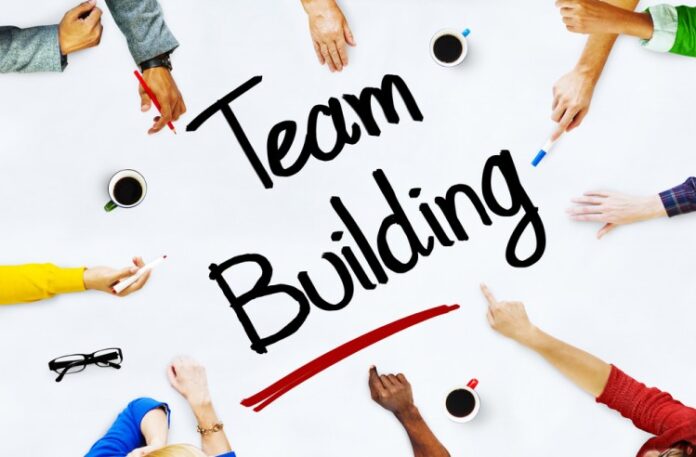
Team building is far more than just a buzzword; it’s the glue that holds organizations together. Remember a time when you joined a new team and felt like a fish out of water?
Effective team building can transform that feeling into one of belonging and purpose. It sets the stage for employee engagement, ensuring that everyone feels valued and heard. And trust me, when everyone’s on board, the sky’s the limit!
The Foundation of Successful Team Building

Define Clear Goals and Objectives
Let’s start with the basics. Ever been on a road trip without a map? That’s what it feels like to be part of a team without clear goals.
Aligning goals with the organizational mission ensures everyone is rowing in the same direction. And when setting these goals, remember the SMART principle: Specific, Measurable, Achievable, Relevant, and Time-bound.
Pro tip: When brainstorming goals, involve members in the process. It fosters a sense of ownership and commitment.
Foster Open Communication
Communication is the lifeblood of any team. Transparent communication ensures everyone is on the same page, reducing misunderstandings and fostering trust.
Speaking of trust, it’s like the foundation of a house. Without it, everything crumbles. By promoting open dialogue, you’re building trust brick by brick.
Fun fact: Did you know that in some team building activities in Canberra, they emphasize the importance of non-verbal communication? It’s all about reading between the lines!
Building a Positive Culture

Promote Inclusivity
Inclusivity isn’t just a trendy term; it’s a necessity. Embracing diversity in the team brings a plethora of ideas, perspectives, and skills to the table. It’s like having a potluck where everyone brings a unique dish.
The result? A feast of creativity and innovation. And to truly benefit from this diversity, it’s essential to create an inclusive environment where everyone feels they belong.
Pro tip: Regularly check in with members to ensure they feel included and valued.
Encourage Collaboration
Two heads are better than one, right? Collaborative teamwork amplifies this notion. It’s about leveraging the strengths of each member to achieve a common goal.
And in today’s digital age, there are countless tools and techniques to facilitate collaboration, from shared documents to video conferencing.
Fun fact: Collaborative teams tend to be more innovative because they combine different perspectives to find unique solutions.
Employee Recognition and Appreciation

Acknowledging Individual Contributions
We all crave recognition. It’s a basic human need. Recognizing individual contributions not only boosts morale but also increases productivity. It’s like giving a plant sunlight; it thrives!
And remember, recognition doesn’t have to be grand. Sometimes, a simple “thank you” can make all the difference. Personalized appreciation methods, like handwritten notes or shout-outs in meetings, can go a long way.
Pro tip: Keep a gratitude journal. Note down the little things members do and acknowledge them regularly.
Celebrating Achievements
While individual recognition is crucial, let’s not forget the power of celebrating as a team. Whether it’s hitting a milestone or completing a challenging project, these celebrations foster a sense of unity and camaraderie.
It’s like throwing a party after running a marathon. You’ve achieved something great together, and it’s time to revel in that success!
Fun fact: Teams that celebrate together tend to have stronger bonds and better collaboration in the long run.
Empowering Members

Provide Opportunities for Skill Development
Growth is a continuous journey, and as a leader, it’s your responsibility to pave the way. Identifying skills gaps is the first step.
It’s like spotting a pothole on a road; once you see it, you can fix it. Offering training and development initiatives not only fills these gaps but also boosts morale.
Pro tip: Consider hosting monthly skill-sharing sessions where members can teach and learn from each other.
Delegate Responsibility
Empowerment is more than just a word; it’s an action. By delegating responsibility, you’re showing trust in your members.
It’s like handing over the car keys to a new driver. They might be nervous at first, but with time and trust, they’ll drive with confidence. Encouraging ownership of projects ensures that members are invested in the outcomes.
Fun fact: Teams with a higher degree of autonomy tend to be more innovative and proactive.
Assessing and Improving Dynamics

Regular Feedback and Evaluation
Feedback is the breakfast of champions! Regular feedback ensures that the team is on the right track. It’s like a GPS for your team’s journey. And remember, feedback should be a two-way street.
Encourage members to share their insights and suggestions. Continuous improvement strategies, like regular check-ins and retrospectives, can help in refining team processes.
Pro tip: Use anonymous feedback tools to ensure everyone feels comfortable sharing their thoughts.
Handling Conflicts
Let’s face it; conflicts are inevitable. But they don’t have to be destructive. With the right strategies for conflict resolution, you can turn these challenges into growth opportunities. It’s all about understanding different perspectives and finding common ground.
Fun fact: Healthy conflicts can lead to better decision-making and more innovative solutions.
Team Building Activities and Exercises

Icebreakers and Games
Who said team building can’t be fun? Icebreakers and team-building games are a fantastic way to foster camaraderie.
They’re like the appetizers before a main course, setting the tone for what’s to come. And for new teams, icebreakers can be a great way to break the ice (pun intended) and get to know each other.
Pro tip: Rotate the responsibility of choosing the icebreaker to ensure variety and inclusivity.
Off-Site Retreats and Workshops
Sometimes, a change of scenery can work wonders. Off-site retreats and workshops provide a break from the usual routine and offer learning opportunities outside the office. It’s like a mini-vacation with a purpose!
Fun fact: Retreats can lead to unexpected breakthroughs as members are removed from their usual distractions.
Remote Team Building

Challenges of Virtual Teams
The digital age has brought many advantages, but it’s not without its challenges. Overcoming distance and time zone issues can be tricky. But with the right virtual communication tools, you can bridge these gaps.
Pro tip: Schedule regular virtual coffee breaks to catch up and bond.
Effective Remote Team Building Strategies
Building a remote team is like assembling a jigsaw puzzle; each piece is crucial. Virtual team building activities, from online quizzes to virtual escape rooms, can help in maintaining engagement in a virtual environment.
Fun fact: Virtual teams that engage in regular team-building activities tend to have higher job satisfaction rates.
Conclusion

Building an engaged and cohesive team is both an art and a science. It’s about understanding individual strengths, fostering open communication, and celebrating achievements. And remember, every team is unique.
So, find what works best for yours and keep evolving. After all, a team that grows together, stays together!











